
Pegasus 1/72 Supermarine Spiteful F.14
| KIT #: | 1001 |
| PRICE: | AUD $10 on e-paid |
| DECALS: | One option |
| REVIEWER: | Peter Hobbins |
| NOTES: | Replacement cockpit, prop and canopy. |

| HISTORY |
The Supermarine Spiteful’s reputation would probably have
fared better if it had not followed on from the Spitfire. Indeed, it is
inevitably portrayed as the bastard child of a thoroughbred, which in some ways
it was, but the Spiteful also had the potential to be a potent warplane in its
own right. Personally, I think that Supermarine’s major mistake in designing the
Spiteful was in not squaring off the tail surfaces – that way n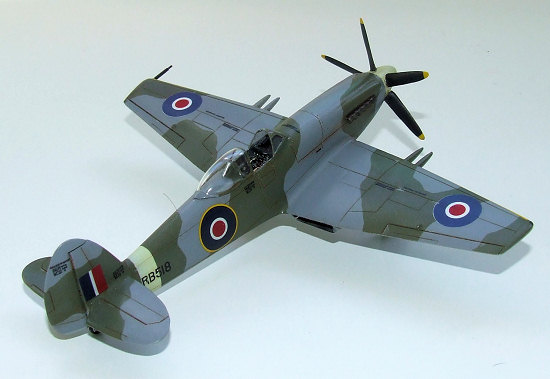 obody
could accuse the type of even pretending to look like a Spitfire!
obody
could accuse the type of even pretending to look like a Spitfire!
More objectively, the Spiteful was a powerful, well-armed and extremely fast piston-engined fighter that appeared just too late to serve during World War II. Test pilots generally found it good to fly, but never in the same league as the sweet handling of the Spitfire. Its squarish laminar-flow wing was optimised for high-speed flight but also led to the type’s major snag: vicious low-speed handling, with a nasty stall. This was partly improved by various airframe changes, but these degraded the upper end of the flight envelope such that the production aircraft was little faster than the preceding Spitfire F.22. Nevertheless, in 1947 the Spiteful F.16 with a Griffon 101 reached 494 miles per hour (795 kph), a record that still stands for piston-engined aircraft in Britain. The end of World War II , coupled with the obvious potential of jet aircraft, killed off any hopes of the Spiteful being built in large numbers, with the original RAF Order of 650 aircraft being reduced to just 22, some of which were sent straight to the scrapyard. The same fate ultimately befell many of the navalised Seafang derivative, which may have had a fighting chance of serving operationally with the Royal Navy if it weren’t for Hawker’s superlative Sea Fury.
| THE KIT |
Given the plethora of Spitfire kits available, it is quite
surprising how little attention has been paid to the Spiteful, especially given
this decade’s fascination with ‘what-if’ types. In 1:72 Rareplanes produced a
characteristically nice vacform of the type in the 1970s, while CMR released
both Spiteful and Seafang resin kits a few years ago to mixed reviews. This
Pegasus kit (I suspect their first, given its number of 1001) hails from the
early 1980s when ‘limited run’ meant extremely thick but soft plastic, unusual
engineering, rather deep panel lines and minimal detail parts. Nevertheless, the
dozen or so injection-moulded pieces that comprise this kit are well formed and
fit together reasonably soundly. The kit also came with white metal
undercarriage and propeller blades, plus a vacformed canopy which must have
yellowed or cracked as I threw it out early in the build. A full set of decals –
including some stencilling and the propeller logos – are also included for the
F.14 prototype, RB515. While the national markings had unfortunately become
stained somewhere in the long life of the particular kit I bought off eBay, the
stencil decals still worked very well. As this was a bagged kit, the
instructions simply comprise a number of written steps and a three-view diagram
of the aircraft, although without any camouflage scheme details.
Spiteful and Seafang resin kits a few years ago to mixed reviews. This
Pegasus kit (I suspect their first, given its number of 1001) hails from the
early 1980s when ‘limited run’ meant extremely thick but soft plastic, unusual
engineering, rather deep panel lines and minimal detail parts. Nevertheless, the
dozen or so injection-moulded pieces that comprise this kit are well formed and
fit together reasonably soundly. The kit also came with white metal
undercarriage and propeller blades, plus a vacformed canopy which must have
yellowed or cracked as I threw it out early in the build. A full set of decals –
including some stencilling and the propeller logos – are also included for the
F.14 prototype, RB515. While the national markings had unfortunately become
stained somewhere in the long life of the particular kit I bought off eBay, the
stencil decals still worked very well. As this was a bagged kit, the
instructions simply comprise a number of written steps and a three-view diagram
of the aircraft, although without any camouflage scheme details.
| CONSTRUCTION |
The most glaring omission from this kit is any form of
cockpit detail; I can’t even recall if it came with a seat! In any case, I used
a spare Spitfire resin cockpit to dress up the interior. Strictly speaking this
is incorrect – the Spiteful’s cockpit was apparently quite
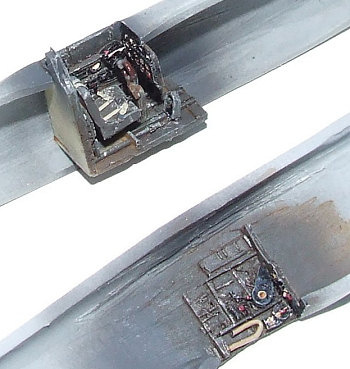 different from the
Spitfire – but without any reference photos I felt that I could take a bit of
artistic licence. However, in order to fit the resin I had to grind away at the
fuselage sides to thin them to an acceptable level, and ditto with the
instrument panel coaming. It is also necessary to sand the fuselage halves flat
along the join to improve the mating surface. Before they were joined together,
I also opened out the tailwheel well, which was otherwise moulded solid. These
steps may sound like a chore but the soft plastic makes the process pretty
straightforward provided that one is careful not to slip..
different from the
Spitfire – but without any reference photos I felt that I could take a bit of
artistic licence. However, in order to fit the resin I had to grind away at the
fuselage sides to thin them to an acceptable level, and ditto with the
instrument panel coaming. It is also necessary to sand the fuselage halves flat
along the join to improve the mating surface. Before they were joined together,
I also opened out the tailwheel well, which was otherwise moulded solid. These
steps may sound like a chore but the soft plastic makes the process pretty
straightforward provided that one is careful not to slip..
Once the fuselage was assembled, the next step is to add the
vertical tail and fair it in. Again, not a hard task but I did make a boo-boo
here. The rudder is separate but what I didn’t appreciate is that, like the very
last Spitfires, it does not extend all of the way down the fin. In fact, the
bottom of the ‘rudder’ part should be cut off and faired in to the end of the
fuselage. Oh well, it still looks convincing even if it’s wrong!
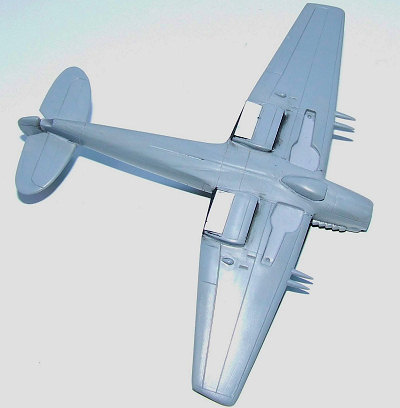
Before attaching each of the one-piece mainplanes to the fuselage, I took time to deepen the wheel wells, although they remain quite shallow. Unfortunately the engineering of the kit means that when the wings join the fuselage there is a join line within the wheel well. Several layers of Gunze Mr Surfacer and some rather convoluted sanding angles helped remove this, but the wheel wells remain probably the weakest area of the kit. Thankfully the underwing radiators are supplied as separate pieces, as this gave me the opportunity to hollow them out and add small strips of wire mesh inside to simulate the cooling cells. I chose to simply slice off the solid radiator ‘flaps’ and replaced them with plastic card, slightly opened out. Again, none of this is difficult provided one works carefully.
I baulked at making up the kit’s combination of injection spinner and metal prop blades, so I turned to Aeroclub for a solid metal replacement. This necessitated ensuring that the cowling was perfectly round and a hole then had to be drilled into the front to accept the prop’s mounting shaft. The remaining steps comprised cutting out some undercarriage doors from plastic card (a template is provided in the instructions) and adding a new canopy. This one was a spare from the Ventura Spitfire F.22, trimmed slightly to represent the tapered rear shape of the Spiteful canopy.
| COLORS & MARKINGS |
While the kit provides decals for the F.14 prototype, I
wanted to model the sole record-breaking F.16, RB518. The camouflage patterns
for these two marks d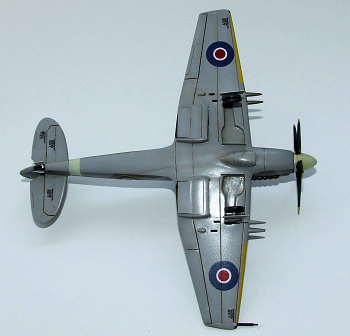 iffered
slightly, so I needed to consult with a few photos to produce an accurate
scheme. As usual I painted the various RAF shades from the Gunze range,
minimising the post-fading as this aircraft was well looked after and did not
have a long flying career. The national markings came from the spares box, and
as mentioned several of the kit’s 25-year-old decals were used without drama.
After sealing with Future I ran a light wash of thinned raw umber oil paint into
the panel lines, then sprayed the airframe in Gunze flat clear to leave a
slightly satin sheen. A light exhaust streak was added with Tamiya weathering
pastels (a fantastic product), the undercarriage was attached, the propeller
glued in place and – voila! – another old kit is rescued from eBay!
iffered
slightly, so I needed to consult with a few photos to produce an accurate
scheme. As usual I painted the various RAF shades from the Gunze range,
minimising the post-fading as this aircraft was well looked after and did not
have a long flying career. The national markings came from the spares box, and
as mentioned several of the kit’s 25-year-old decals were used without drama.
After sealing with Future I ran a light wash of thinned raw umber oil paint into
the panel lines, then sprayed the airframe in Gunze flat clear to leave a
slightly satin sheen. A light exhaust streak was added with Tamiya weathering
pastels (a fantastic product), the undercarriage was attached, the propeller
glued in place and – voila! – another old kit is rescued from eBay!
| CONCLUSIONS |
While the ‘limited run’ industry has come a long way since the pioneering days of Pegasus, this doesn’t mean that their kits are junk. This Spiteful kit took some extra work but mostly it was a pleasure, involving some good old-fashioned modelling skills and a bit of elbow grease. While I couldn’t resist adding a few modern updates such as a resin cockpit and an aftermarket propeller, the basic kit goes together without much hassle and very much looks the part. Apart from the simplified panel lines, it matches the plans I have of the Spiteful and looking at it now, I have a renewed respect for the beauty of this type, even if it has been called “a Spitfire too far”. In fact, I bought two of these kits in the same eBay batch, and I have every intention of turning the second into a Seafang quite soon.
| REFERENCES |
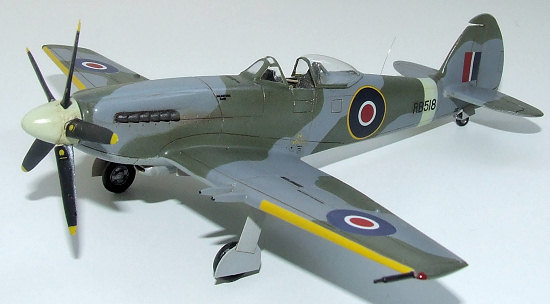 Alfred Price. ‘A Spitfire too far: the Supermarine
Spiteful’. Aeroplane Monthly, July 2001, 36–41.
Alfred Price. ‘A Spitfire too far: the Supermarine
Spiteful’. Aeroplane Monthly, July 2001, 36–41.
Francois Prins. ‘Spiteful and Seafang: end of the line’. Flypast, September 1986, 22–25.
Tony Buttler. British Secret Projects: Fighters & Bombers 1935–1950. Hinckley: Midland Publishing, 2004.
Robert Humphreys. Modellers Datafile No. 5: The Supermarine Spitfire (Part 2: Griffon-Powered). Bedford: SAM Publications, 2001.
December 2007
Copyright ModelingMadness.com. All rights reserved. No reproduction in any form without express permission from the editor.
If you would like your product reviewed fairly and quickly, please contact the editor or see other details in the Note to Contributors.